The Iterative Eight Steps for Solving Problems – Step 8: Implementing
These elaborations build upon the Iterative Eight Steps framework developed in previous episodes of our newsletter and blog. After diagnosing and analyzing the problem and designing a strategic solution, organizations must take the decisive eighth step: implementing (see Exhibit 1). This is where ideas meet reality and managerial competence is tested through disciplined execution. These elaborations explain how structured implementation transforms strategic intention into sustained performance.
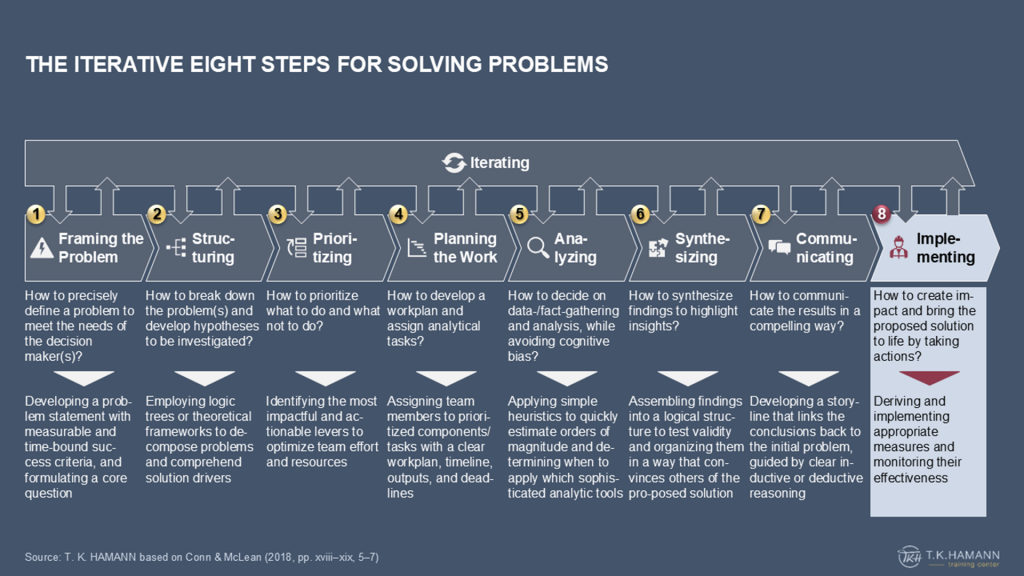
1. The Strategic Role of Implementation
Implementation is the most critical yet underestimated phase of organizational transformation. Many firms devote extensive effort to strategy formulation, process redesign, and analysis, yet pay comparatively little attention to how those plans will be realized. This imbalance creates what practitioners call the implementation gap: the persistent discrepancy between what is envisioned and what is achieved.
The implementation gap often arises not because the plans are flawed, but because the execution is fragmented. Managers may underestimate the complexity of aligning multiple departments, technologies, and people behind a single direction. Implementation requires translating conceptual designs into actionable steps, assigning clear ownership, and maintaining discipline through uncertainty.
An effective implementation process closes the gap between strategic vision and operational practice. The goal is not merely to “roll out” new processes, but rather to embed them—to make change habitual. This process requires a balance of structure and flexibility, planning and adaptation, and control and communication.
Managerial Insight: From Blueprint to Behavior During a large process optimization program, the leadership team discovered that a well-designed process did not automatically change behavior. Employees continued their old routines despite the new workflows. A breakthrough occurred when the implementation team translated the abstract process map into tangible daily actions, created job-specific checklists, and trained supervisors to act as coaches. Within three months, compliance rose to 95 percent. The lesson is that implementation succeeds when people understand not only what must change but also how their work will change.
This section establishes the conceptual foundation that implementation is not an afterthought, but rather, the fulcrum of strategic management. Learning how to bridge the implementation gap enables future leaders to transform vision into tangible results.
2. Objectives and Core Principles of Implementation Planning
2.1 Objectives
Implementation planning provides structure and direction for complex execution. Its primary objectives are threefold:
- Ensuring readiness for execution by preparing resources, timelines, and governance structures
- Aligning stakeholders by securing understanding and commitment across all affected groups
- Measurable benefit realization: translating qualitative ambitions into quantitative success criteria
Implementation planning bridges the gap between strategic design and operational practice by providing a coherent framework of goals, principles, and deliverables.
2.2 Core Principles
Four guiding principles underpin effective implementation, drawing on the methodology applied in complex transformation programs:
- Completeness and clarity of deliverables: every measure and work package must be explicitly defined, including its purpose, the responsible party, and the expected outcome; ambiguity at the beginning leads to more confusion later.
- Accountability and ownership: responsibility should rest with individuals, not committees; decision rights and reporting paths must be clear.
- Transparency is achieved through standardized reporting. Consistent formats for progress tracking enable management to identify issues early. Dashboards and “traffic-light” systems make performance visible.
- Iterative validation and communication are essential. Implementation plans are living documents. Regular reviews allow teams to validate assumptions and adapt to new circumstances.
Together, these principles create an environment in which strategic intent is systematically translated into executional discipline. As Exhibit 2 illustrates, the four principles operate as an integrated system balancing control and adaptability. When applied together, they convert strategic intent into executable reality.
These principles were originally formulated to guide the planning of implementation. Yet, once execution begins, they continue to serve as a managerial compass for the disciplined and adaptive realization of plans.
Managerial Insight: Transparency as a Catalyst for Accountability During a service sector transformation, managers introduced weekly digital dashboards that summarized project status across thirty initiatives. Initially, teams resisted the increased visibility, fearing exposure. Over time, however, the dashboards became a source of pride, and units competed to achieve “green” status. By making transparent reporting a standard practice, leadership created a self-reinforcing culture of accountability.
The following sections translate these guiding principles into a sequence of practical phases and deliverables.

3. Structuring the Implementation Framework
Through disciplined structuring, isolated activities evolve into a cohesive system of coordinated action, forming the backbone of effective execution.
3.1 Purpose and Context
Before defining specific activities or detailing deliverables, implementation planning requires a clear structural framework that connects strategic intent with operational execution. This framework ensures all activities are logically organized and traceable to overarching objectives. It also ensures activities are controllable through consistent reporting and accountability.
3.2 Three-Level Implementation Architecture
A robust implementation follows a hierarchical architecture linking strategic objectives to actionable steps.
- Project defines the overall transformation goals and strategic intent.
- Work packages group related initiatives into coherent thematic areas that contribute to these goals.
- Measures represent the concrete actions required to achieve the objectives of each work package.
This three-level structure ensures manageability and alignment between design and execution. It enables leaders to maintain a strategic overview while tracking progress at the most granular level.
3.3 Defining and Aligning Implementation Measures
Once the three-level framework has been established, each measure must connect strategic intent to operational execution. A well-formulated measure specifies its objective, expected deliverable, responsible owner, timeline, and resource requirements. This level of clarity prevents ambiguity later in the implementation process and enables consistent reporting across work packages.
However, defining measures in isolation is not sufficient. They must be aligned and interconnected within the broader implementation framework. Dependencies among measures determine the logical sequence of execution: what must happen first, what can proceed in parallel, and what relies on preceding outputs. Understanding these interrelations helps prevent bottlenecks, ensure resource efficiency, and foster synchronization across workstreams.
Section 4.2 (Structuring and Sequencing Deliverables) addresses the practical design and visualization of these relationships and introduces a formal dependency mapping tool. In the SSection 4.2, Exhibit 4 (measure dependency diagram) illustrates how to chart these linkages to achieve transparency and proactive coordination in complex implementation environments.
3.4 Integrating Time, Cost, Responsibility, and Expected Effect
Each measure should be documented in an action plan that incorporates the essential control dimensions:
- Time: Start and end dates, milestones, and sequencing
- Cost and resources: Budgeted effort or financial requirements
- Responsibility: Accountable owner and supporting roles
- Expected effect: Targeted improvement in performance or financial impact
Integrating these parameters provides transparency and allows progress and benefit realization to be monitored systematically.
Managerial Insight: Dependency Mapping in Complex Programs In a large industrial transformation program, more than 400 measures were initially managed in isolation. However, by introducing a dependency matrix, managers were able to visualize how design, procurement, and training activities interacted. Identifying these interdependencies reduced the total implementation time by 15 percent and minimized downstream delays, demonstrating that increased visibility is the first step toward achieving agility.
Now that the structural logic of projects, work packages, and measures has been established, the next step is to translate this framework into a phased implementation plan. This plan should define concrete deliverables, sequencing, and governance mechanisms for execution.
4. Phases and Deliverables of Implementation Planning
Implementation is not a single leap, but rather a disciplined sequence of phases. Each phase produces specific deliverables that, collectively, ensure readiness and control. Based on the methodology refined through large-scale transformation projects, there are six distinguishable phases.
Exhibit 3 illustrates the six interlinked phases of implementation planning: defining goals, structuring and sequencing deliverables, aligning with stakeholders, establishing governance and responsibilities, monitoring and steering progress, and documenting, learning, and institutionalizing results. The diagram shows how each phase produces specific deliverables while feeding back into earlier steps through continuous communication and control loops. This creates a dynamic, learning-oriented planning cycle.
Exhibit 3 not only depicts the six phases of implementation planning, but also the feedback logic that makes the process iterative rather than linear. The communication loop links phases 3–6 back to phases 1–2 because stakeholder reactions, information needs, and alignment issues that arise during execution often necessitate the refinement of earlier goals and structural assumptions. Similarly, the control loop connects phase 5 to all preceding phases becauseinsights from monitoring and steering may necessitate adjustments to objectives, sequencing, communication, or governance. However, the loop does not extend into phase 6 since documentation and institutionalization occur after active steering ends. Together, these two loops demonstrate that implementation planning is a learning system that continuously validates and adapts its own premises as execution progresses.
These six phases form the backbone of disciplined implementation planning, ensuring that strategy becomes an operational reality.
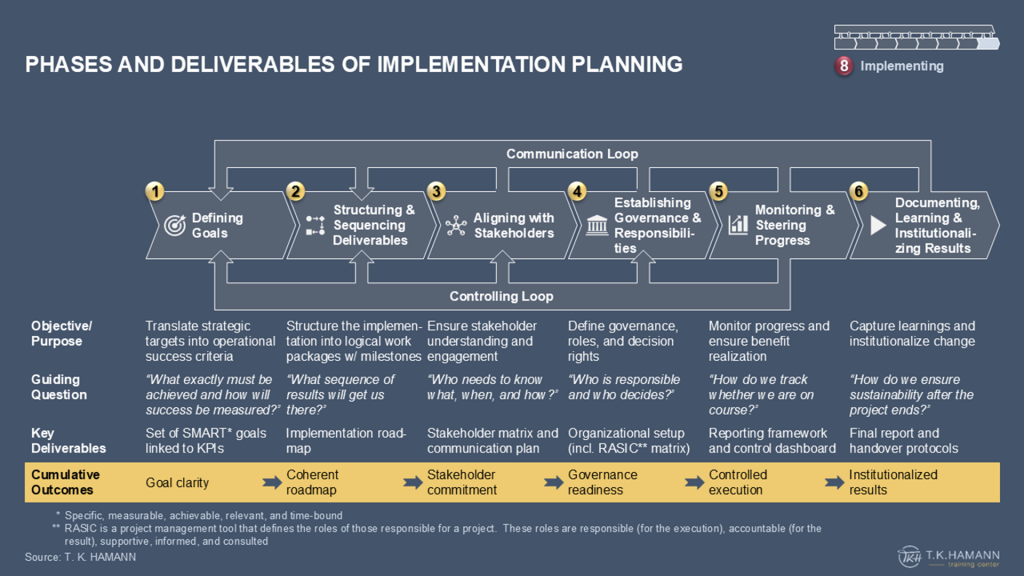
4.1 Defining Goals
The first step in implementation is translating strategic targets into measurable operational objectives. Managers must clearly define what “success” looks like in terms of time, cost, quality, and scope. See the success criteria established in the problem statement during the first phase of the iterative eight steps, called “framing the problem.” Without this clarity, subsequent control becomes impossible. Goals should be aligned both vertically (from corporate to functional) and horizontally (across departments).
4.2 Structuring and Sequencing Deliverables
After the goals have been defined, the work is divided into packages and sub-packages, each of which produces a specific end product. These products may include new processes, IT modules, training materials, or organizational changes.
Exhibit 4 shows how measures should be sequenced based on logical and operational dependencies rather than arbitrary preferences or timing conveniences. The measure dependency diagram shows which activities can be executed in parallel (“order does not matter”) and which require a strict before/after relationship to prevent rework, resource conflicts, and delays downstream. Visualizing dependencies in this manner enables implementation leaders to determine critical paths, identify bottlenecks early on, and develop a phased rollout strategy that ensures the feasibility and stability of execution, rather than merely theoretical completeness.
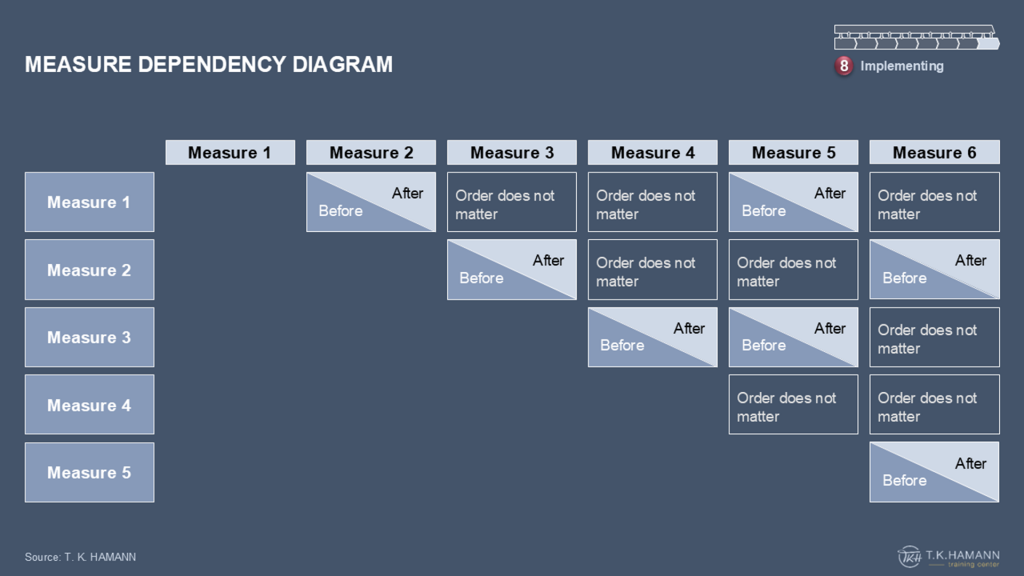
A detailed action plan connects these elements to timelines and resources. It translates each defined measure into an executable schedule by assigning a specific implementation period, expected benefit, required budget, and current status (see Exhibit 5). While the chart focuses on time, benefit, budget, and status, the underlying assignment of measure dependencies, as shown in Exhibit 4, is defined in preceding planning steps and implicitly flows into this action plan. Thus, the action plan operationalizes what was pre-engineered structurally in earlier phases and serves as the primary instrument for disciplined execution.
The primary outcome at this stage is a coherent implementation roadmap that sequences all work packages and measures based on their logical and temporal dependencies. To validate feasibility and ensure realistic sequencing, each measure has been assigned a provisional responsible party within the action plan. These assignments are not yet formalized in governance terms and will be confirmed and embedded in the official decision and reporting structure in step 4.
This dependency logic is not a technical nuance; it encapsulates a fundamental managerial principle: implementing measures in the wrong order can destroy more value than the measures are designed to create, thereby destabilizing core infrastructures.
Managerial Insight: Sequencing for Stability in Infrastructure Change An energy utility company tried to implement new maintenance procedures across all its plants simultaneously. However, early disruptions revealed overlooked interdependencies. The project team then restructured the implementation process into phases aligned with regional readiness levels. Although this extended the schedule, it dramatically improved reliability. The team concluded that phased execution is smarter, not slower.
The next step is to address the communication architecture needed to align all affected stakeholders with the implications of the roadmap and its emerging action plan.

4.3 Aligning with Stakeholders
A well-structured communication plan keeps stakeholders informed and engaged. It specifies the purpose, medium, frequency, and responsible communicator for each message. Internal and external communication cycles, from board briefings to employee town halls, must be synchronized with implementation milestones.
The two key deliverables of this step are a stakeholder matrix and a communication plan. The stakeholder matrix identifies and classifies all relevant internal and external audiences according to their interest, influence, and required level of engagement (see Exhibit 6). Based on this analysis, the communication plan translates these insights into specific messages, channels, senders, timing, and frequency (see Exhibit 7). Together, these two documents ensure that communication is a deliberately engineered mechanism for alignment, expectation management, and commitment building, rather than an ad-hoc reaction as implementation unfolds.
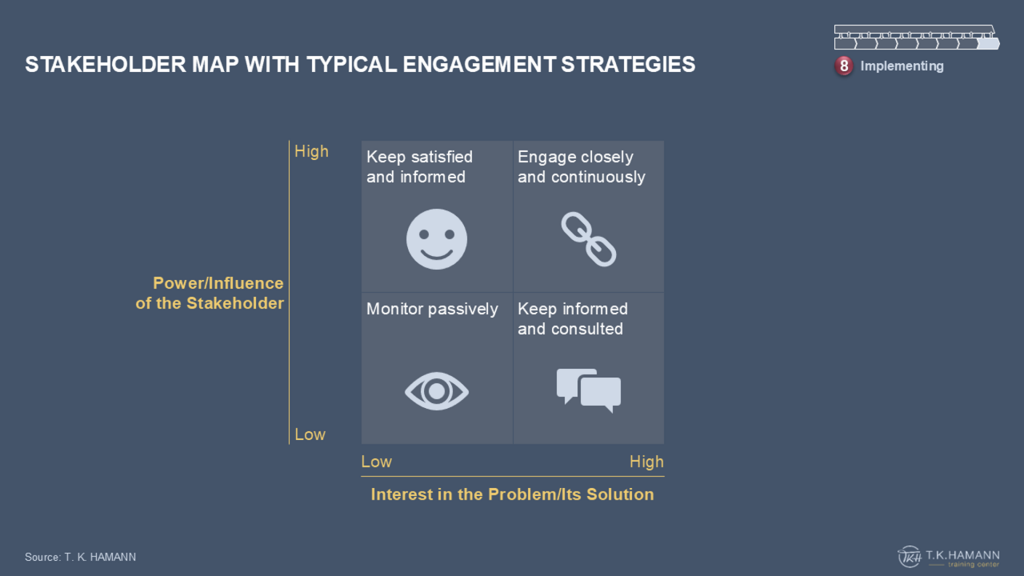
The stakeholder map developed during the framing phase is used here as the analytical basis for implementation planning. While its initial purpose was to identify those affected by the problem, it now informs how these stakeholders must be engaged during execution. In this implementation view, top management and the steering committee, which are overseen by the program leadership, must be actively aligned to secure sponsorship and decision-making speed. Middle managers, which are overseen by workstream leads, require continuous involvement to translate measures into operational routines. Employees, which are overseen by HR and line managers, must be informed and empowered to adopt new behaviors. Works councils or legal bodies, which are overseen by HR and Legal, must be consulted to ensure compliance and legitimacy. External partners or suppliers, which are overseen by procurement or interface managers, require targeted information to maintain coordination. Thus, the map not only classifies stakeholders by influence and interest but also links them to explicit ownership and engagement logic for implementation.
Once stakeholder alignment has been secured through structured communication, the next step is to formalize the governance structure and assign final responsibilities to ensure implementation within the line organization.
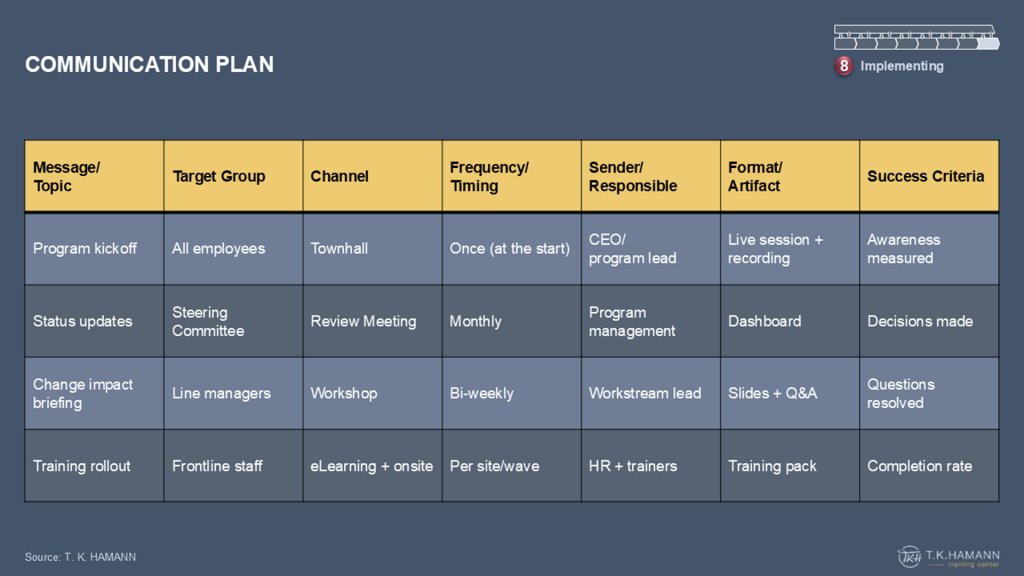
4.4 Establishing Governance and Responsibilities
Exhibit 8 illustrates the implementation governance logic by making accountability, decision paths, and interfaces explicit. The steering committee provides strategic oversight and escalation authority. The program leadership layer ensures cross-workstream coordination, control, and communication. The workstream leads assume operational responsibility for executing measures within their domains. The chart shows how implementation is anchored in a defined decision and coordination architecture rather than left to informal arrangements by translating the role descriptions given in the text into a structured hierarchy.
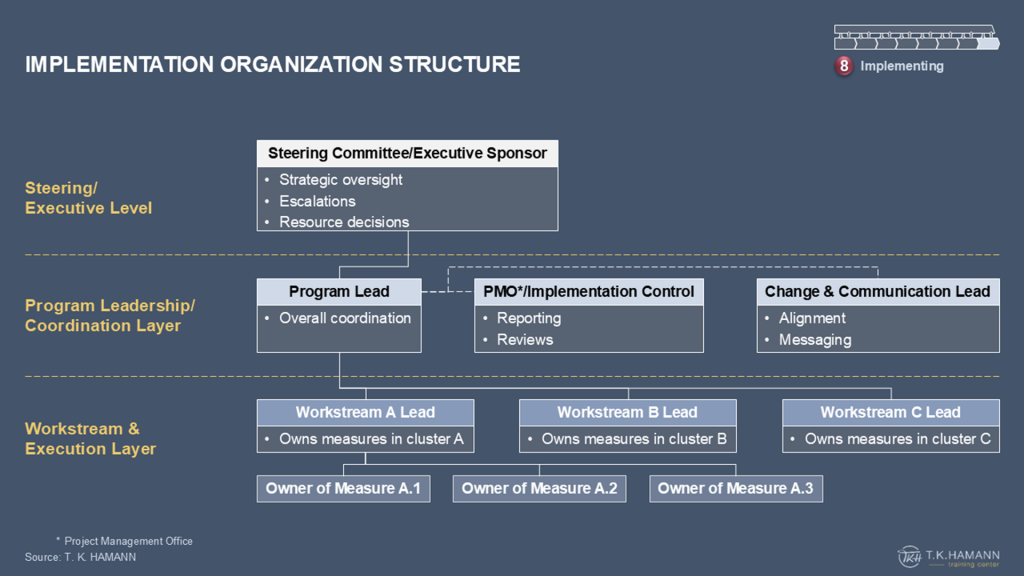
Exhibit 9 outlines the functional responsibilities of each level within the implementation organization. While the structural chart defines reporting lines and decision paths, this exhibit clarifies how each role contributes to execution, translating the governance architecture into concrete behaviors.
The transition from the implementation organization to the line organization signifies the shift from temporary, project-based responsibility to enduring operational ownership. During the implementation phase, dedicated governance structures, steering mechanisms, and support roles ensure disciplined execution and problem resolution. Once the measures have been delivered and stabilized, accountability must migrate to the permanent line units that will operate, refine, and sustain the new processes in everyday practice. This transition is not merely administrative. It ensures that realized benefits are preserved, improvements become part of normal management routines, and implementation success is not lost once the project structure dissolves.
After governance roles and responsibilities are formally established, the next step is to activate this structure through a disciplined system of monitoring and steering. This system translates accountability into measurable control of implementation progress.

4.5 Monitoring and Steering Progress
Implementation control operates along two dimensions:
- Measure control, which tracks the completion of tasks
- Effect control, which verifies the realization of intended benefits
Hierarchical reports summarize these dimensions from individual measures to executive overviews, enabling decision-makers to intervene early.
To ensure the action plan functions as both a record and a steering instrument, clear rules are defined for interpreting status, escalation, and benefit control. Exhibit 10 summarizes these rules within an integrated tracking system.

The tracking system establishes the criteria for interpreting and governing implementation progress. It combines three essential steering elements: traffic-light logic, which specifies the conditions under which a measure is considered on track, at risk, or off track; and potential control, which links status to activity completion and the realization of the intended benefit; and escalation rules, which determine the level at which an issue must be raised if mitigation fails. By integrating status logic, escalation criteria, and benefit realization into a single framework, the tracking system ensures that implementation control is rule-based, comparable across workstreams, and outcome-oriented rather than activity-oriented.
Measure control monitors the progress of implementation and the likelihood of realizing the defined potential. The action plan is the primary control instrument and is interpreted using predefined status rules, escalation criteria, and potential-tracking logic. At this stage, potential is assessed for likelihood rather than evidenced. Finance confirms the calculation logic, key benefit drivers are monitored, and first observable impacts are reviewed for directional validity. Therefore, the question addressed in measure control is not whether the benefit has already materialized, but rather, given the current execution status and leading indicators, whether benefit realization remains realistic under the existing implementation trajectory.
The measure control dashboard (see Exhibit 11) consolidates all implementation measures into a single management view, enabling rapid, evidence-based decision-making. It visualizes the status of each workstream and measure using standardized traffic-light coding, planned versus actual progress indicators, and key execution metrics. By aggregating information on schedule adherence, completion rates, and emerging risks, the dashboard gives decision-makers a transparent, real-time overview of the implementation landscape. Rather than merely serving as a reporting tool, the dashboard functions as a dynamic control instrument that translates raw progress data into managerial action.
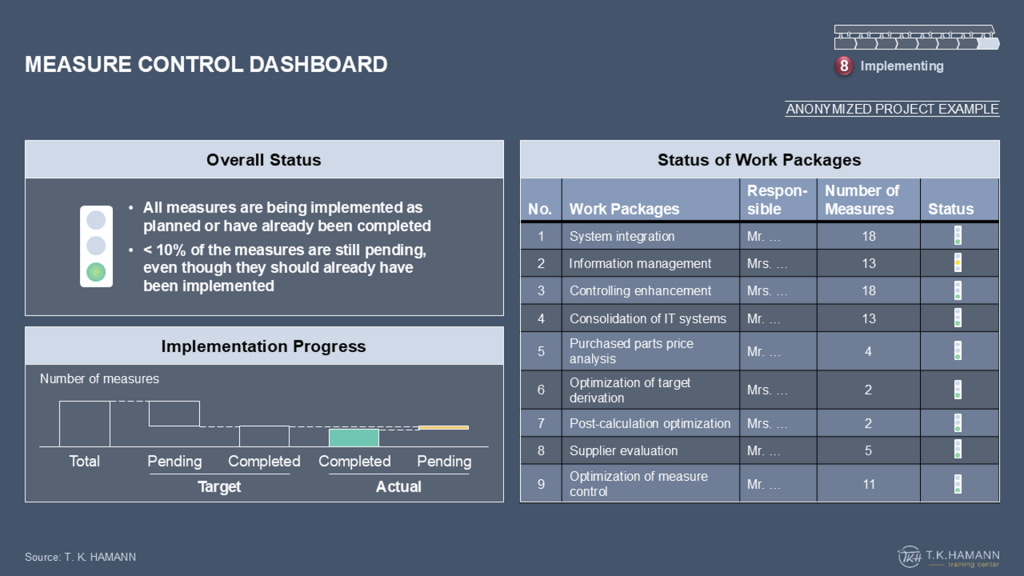
Exhibit 12 complements the consolidated project view by displaying progress at the level of individual measures. It provides a transparent overview of the implementation status, start and end dates, responsible owner, and latest progress commentary of each measure. Standardized traffic-light coding ensures comparability across workstreams. Completion percentages and remarks allow for precise tracking of deviations from the plan. This level of granularity enables program leaders to detect early warning signals, verify ownership, and initiate corrective action before risks escalate to higher governance levels.

Effect control begins only after implementation is complete and the new processes or solutions are operating under stable conditions. Unlike potential tracking, which deals with plausibility during implementation, effect control verifies the realized outcome after the fact. The guiding question here is whether the intended effects have materialized. This verification uses observed performance metrics rather than assumptions, calculations, or drivers. Verification requires a defined measurement window and clear attribution logic to prevent prematurely claiming effects or crediting them to unrelated developments. Effect control thus transforms expectations into evidence and prevents the systematic overstatement of implementation success.
The effect control dashboard, shown in Exhibit 13, provides a structured overview of verified outcomes after implementation is complete and operations have stabilized. It consolidates key categories, such as cost reduction, revenue increase, time savings, and quality improvements. Each category is quantified through defined key performance indicators (KPIs) and, where applicable, converted into monetary values. By comparing verified results against original targets, the dashboard provides evidence-based confirmation of achieved effects, rather than forecasts or assumptions. This allows management to validate actual benefits, ensure financial transparency, and promote learning for future implementation cycles.
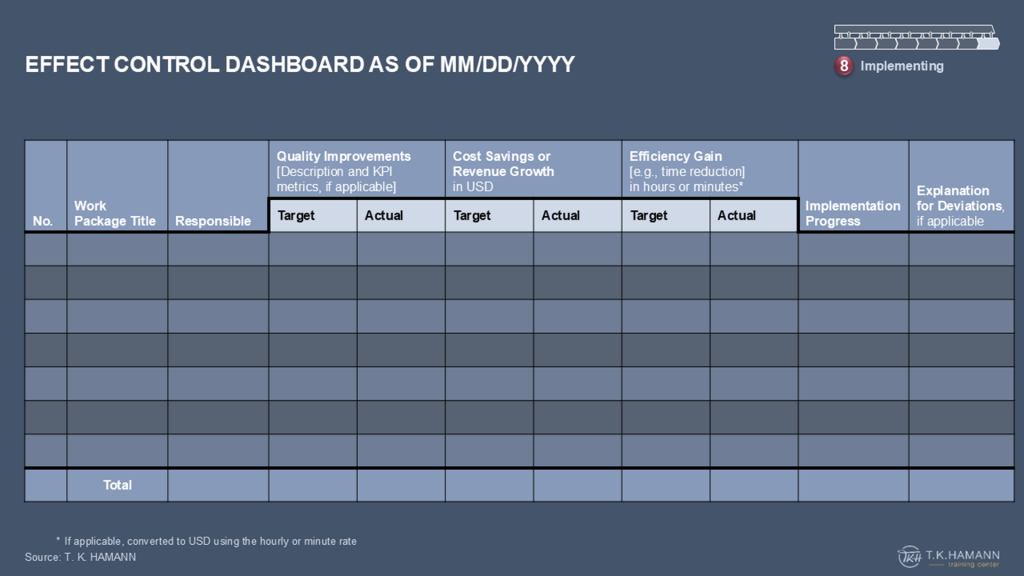
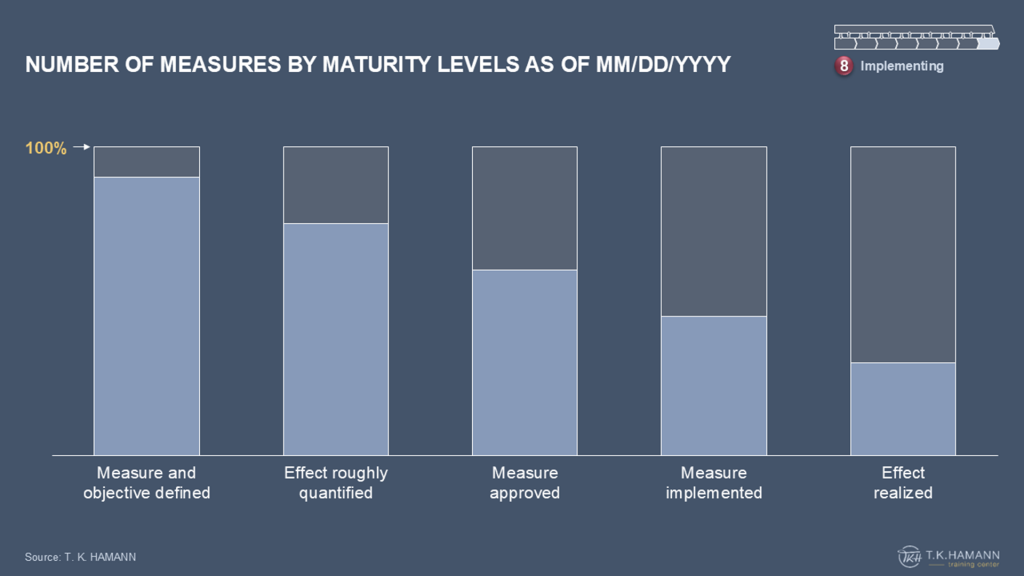
Implementation reviews translate the two control dimensions into managerial actions. Intermediate reviews focus on course correction. They examine the status of measures, the likelihood of their realization, and any unresolved risks requiring intervention or escalation. Final implementation reviews serve a different purpose. They validate the completion of measures, confirm handover to the line organization, and close the effect-control loop by documenting verified results and lessons learned. Crucially, reviews are decision-making forums, not reporting rituals; they must lead to reprioritization, mitigation, escalation, or closure. By doing so, reviews anchor discipline in the governance system and ensure implementation is actively steered rather than passively observed.
Simply reporting deviations or delays is not enough to ensure successful implementation. Effective control requires active problem solving, such as working directly with responsible parties to identify root causes, remove obstacles, and realign measures with their original objectives. Through regular dialog, coaching, and joint issue resolution, reporting evolves from passive monitoring to active management, restoring progress and maintaining accountability across the implementation portfolio.
The final step is to consolidate the outcomes in a form that preserves what has been achieved and learned for the organization once the implementation phase concludes. This step is preceded by active steering of implementation progress through measure control, effect verification, and structured reviews.
4.6 Documenting, Learning, and Institutionalizing Results
The final phase consolidates the journey. Comprehensive documentation captures deliverables, deviations, and lessons learned. Formal handover ensures the line organization assumes ownership of the results.
Exhibit 15 illustrates the phased transition from project-driven execution to sustainable line ownership. The chart shows how responsibility, governance, and capability gradually shift from the implementation organization to the permanent structure in four stages: implementing measures, stabilizing operations, transferring accountability, and institutionalizing results. The chart emphasizes that true implementation success is achieved only when new practices are fully embedded in the organization and performance becomes self-sustaining without project support by visualizing this progression.
Having established the conceptual foundations and structure of implementation measures, we will now transition from the “what” and “how” of planning to the “who” and “authority.” Implementation does not happen through documents alone; it happens through people, roles, and disciplined coordination.
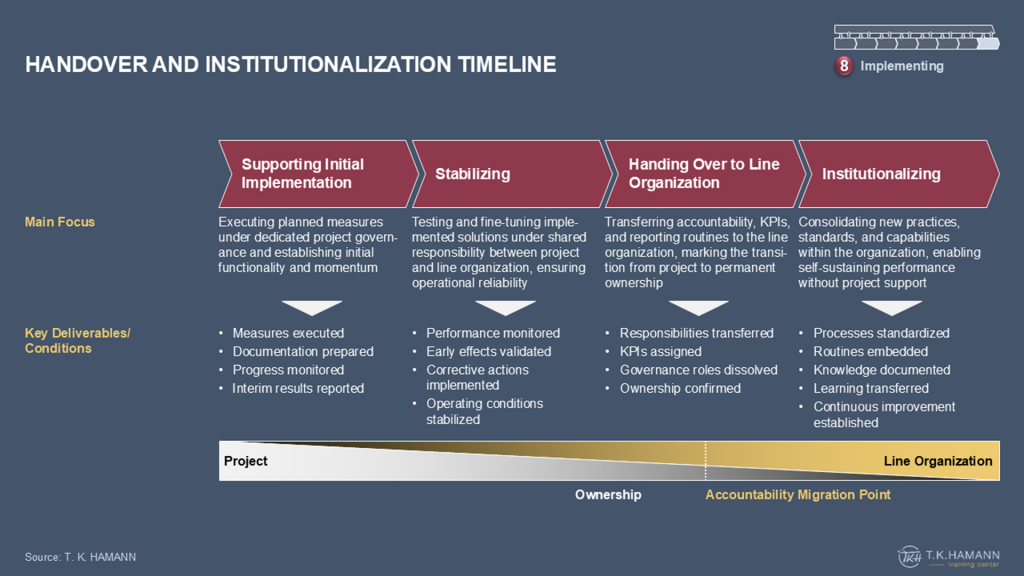
5. Leading the Implementation Organization
Effective leadership transforms governance structures into living systems of accountability and collaboration.
Success is not determined by the formal framework itself, but rather by how leaders activate it through consistent behaviors that balance control and empowerment, structure and trust, and rigor and adaptability.
Implementation leadership is about motion: maintaining focus, aligning people, and ensuring successful ownership transfer from project to line.
The following section explores how leaders make these systems work in practice by orchestrating transitions, modeling execution discipline, and building a culture that sustains results long after the project ends.
5.1 Managing the Transition from Project to Line Leadership
Implementation leadership is most critical at transition points, such as when authority and responsibility shift from the temporary project structure to the permanent line organization. Although Exhibits 8 (Implementation Organization Structure) and 15 (Handover and Institutionalization Timeline) illustrate the formal governance setup and the gradual migration of accountability, respectively, leading this transition requires deliberate management attention.
Leaders must ensure continuity of purpose while shifting the focus of decision-making. In the early phases, the project organization provides guidance, methodological rigor, and momentum. As implementation stabilizes, the line organization must increasingly take the lead, receiving support rather than direction from the project team. This overlap phase is essential because it enables joint steering, mirrored reporting, and on-the-job coaching, which builds confidence and capability. Successful leaders manage this shift by:
- Preparing successors early by identifying line managers who will assume future accountability and involving them in decisions before the formal handoff
- Simplifying governance mechanisms by gradually reducing meeting frequency, approvals, and external coordination to fit everyday operations
- Fostering ownership by publicly acknowledging line responsibility and celebrating early wins that demonstrate independence
Ultimately, the transition is as much behavioral as it is structural. Leadership maturity is measured by the ability to successfully transfer control, rather than by the amount of control retained.
5.2 Leadership Behaviors that Drive Implementation Success
Effective implementation leaders exhibit a consistent set of behaviors beyond their formal roles. These behaviors align teams, sustain discipline, and model the culture of execution. Four behavioral dimensions stand out:
- Clarity and focus: Communicating priorities with precision and ensuring that every participant understands how their contribution supports the overall objectives. Implementation fails when people are busy but misaligned.
- Accountability and follow-through: Holding teams accountable for their commitments while providing support to overcome obstacles. Effective leaders foster a culture where commitments matter.
- Constructive escalation: Encouraging transparent discussion of issues without blame. Escalation is treated as a management tool, not a sign of weakness.
- Empowerment and coaching: Delegating decision-making authority to those closest to the work while providing guidance to strengthen competence and confidence.
These behaviors transform the governance model into a lived practice. They ensure that meetings generate action, that dashboards trigger discussion, and that reporting reinforces—rather than replaces—leadership dialog.
5.3 Building a Culture of Execution
Sustainable implementation depends on creating an organizational climate in which execution excellence becomes the norm. Such a culture rests on three pillars:
- Transparency: Progress, risks, and interdependencies are openly communicated. Transparency eliminates surprises and fosters collective responsibility.
- Discipline: Plans are respected, milestones are monitored, and corrective action is taken without delay. Discipline does not mean rigidity; it means reliability.
- Learning: Mistakes and deviations are analyzed to improve systems rather than to punish individuals. This ensures that each implementation strengthens the organization’s capability for the next one.
Leaders embed these values by consistently modeling them. A culture of disciplined execution takes root when executives discuss implementation progress with curiosity instead of blame, when teams update dashboards promptly, and when lessons learned are shared rather than hidden.
6. Communication and Stakeholder Alignment
Effective implementation depends on leadership behaviors and cultural foundations, as well as how communication aligns stakeholders and sustains engagement across the organization. This topic is explored in this section.
Communication is the heartbeat of implementation. It transforms plans into a shared purpose, data into meaning, and progress into collective confidence. When managed effectively, communication fosters the trust and transparency necessary to sustain momentum, especially in complex, multi-phase programs.
This section demonstrates how communication serves as a strategic instrument of leadership, creating alignment, maintaining motivation, and ensuring that every stakeholder sees their contribution to the broader story of transformation.
Ultimately, effective communication and stakeholder alignment transform implementation from a managerial task into a unifying organizational movement.
6.1 Designing the Communication Architecture
Every implementation program requires a deliberately designed communication architecture—a structured yet flexible system of messages, channels, and cycles that ensures the right information reaches the right audience at the right time. This architecture connects three dimensions:
- Audiences: Executive sponsors, line managers, project teams, and broader employee groups all need messages tailored to their roles and concerns.
- Messages: The content should strike a balance between strategic meaning (“Why we are doing this?”) and operational relevance (“What changes tomorrow?”).
- Timing: Communication should follow the rhythm of implementation—frequent during early mobilization, focused during execution, and celebratory during closure.
A well-designed architecture integrates formal mechanisms, such as steering-committee reviews, progress newsletters, and dashboards, with informal interactions, such as team briefings and town halls. The goal is coherence, so every message reinforces the same direction, tone, and accountability.
See stakeholder map (Exhibit 6) and communication plan (Exhibit 7) for examples of structured alignment tools.
6.2 Engaging Stakeholders through Dialog
During implementation, communication must evolve beyond one-way broadcasting. True alignment emerges when stakeholders participate, ask questions, and co-create meaning. Leaders who treat communication as a dialogue instead of a distribution create ownership rather than compliance. Key practices include:
- Early involvement: Bringing stakeholders into design discussions builds credibility and reduces resistance.
- Targeted messaging: Tailor content to stakeholder priorities. For example, focus on process reliability for operations teams and on efficiency gains for finance teams.
- Feedback loops: Provide mechanisms to capture reactions, surface concerns, and adjust plans accordingly.
This dialogic approach transforms communication into an engine of commitment.
6.3 Maintaining Momentum through Transparent Communication
During long implementation journeys, enthusiasm naturally fluctuates. Transparent communication is the primary antidote to fatigue and rumors. Honest updates about both challenges and successes maintain trust and signal managerial integrity. Visual dashboards, milestone stories, and internal newsletters make progress visible and tangible.
Effective leaders combine data with narrative; they use facts to demonstrate performance and stories to reinforce purpose. Celebrating small wins, highlighting cross-functional collaboration, and acknowledging effort sustains motivation, even during difficult phases. Transparency also reduces the emotional distance between decision-makers and executors, allowing the organization to see itself as one team pursuing shared results.
6.4 Synchronizing Communication with Implementation Milestones
Communication is most powerful when synchronized with key program milestones. Major announcements, such as launches, phase completions, or handovers, serve as symbolic milestones in the transformation journey. These events provide opportunities to restate purpose, align expectations, and reset focus.
By planning communication alongside implementation phases, leaders ensure that every milestone not only delivers operational progress but also renewed alignment. Thus, the communication plan becomes an integral part of the implementation roadmap, not an afterthought.
7. Implementation Controlling and Progress Reviews
Although communication is essential for keeping the organization aligned and motivated, progress must also be monitored and managed systematically. This section examines how implementation control and structured progress reviews translate transparency into measurable performance and learning.
Controlling is not about bureaucracy; it is about learning through visibility.
Implementing controlling measures and conducting structured progress reviews ensures that an organization stays on track and on purpose. These processes transform numbers into narratives, enabling teams to act on facts and learn from deviations.
By combining measure control (tracking execution) with effect control (verifying results), managers create a feedback system that reinforces accountability and strengthens organizational learning.
Hence, this section explores how control becomes a leadership function, connecting performance measurement with problem-solving to ensure continuous progress.
7.1 Purpose and Logic of Implementation Controlling
The purpose of implementation control is to maintain transparency regarding progress and impact. It gives managers reliable information about the status of ongoing projects, expected benefits, and any deviations that need attention.
Implementation controlling is based on four guiding principles:
- Completeness: All relevant measures and effects are systematically documented.
- Accuracy: Data reflects the current state and is validated by the responsible owner.
- Timeliness: Information is updated in line with implementation cycles.
- Relevance: Indicators highlight performance drivers, not easily measurable factors.
Consistently applying these principles enables control systems to facilitate early intervention rather than retrospective reporting.
7.2 Measure Control: Tracking Activities and Execution Progress
Measure control monitors the execution of individual measures, which are the operational backbone of implementation. It answers the question: “Are the planned actions being executed as intended?”
The measure control dashboard (see Exhibits 10 and 11) provides a concise, visual overview of progress across all workstreams. Standardized traffic-light indicators (red, amber, and green) show whether measures are on track, delayed, or completed. Each entry typically includes start and end dates, the responsible owner, the completion percentage, and commentary on progress or issues. This structure enables managers to identify bottlenecks, prioritize support, and escalate decisions before delays accumulate.
However, reporting alone is insufficient. Leaders must actively engage with measure owners, discussing barriers, offering resources, and jointly defining recovery actions. Effective measure control transforms data into dialog and oversight into support. It is a continuous process of tracking, interpreting, and intervening.
7.3 Effect Control: Validating Impact and Realized Benefits
Effect control complements activity monitoring by verifying that the intended financial, operational, or qualitative benefits have been achieved. While measure control focuses on completion, effect control focuses on outcomes.
The effect control dashboard (see Exhibit 12) consolidates key benefit categories, such as cost reduction, revenue increase, time savings, and quality improvements. Each category is supported by relevant KPIs and, where appropriate, is translated into monetary terms.
This view differentiates between confirmed potential (based on early financial validation and operational indicators) and realized effects (proven through verified results and audited data). By distinguishing between likelihood and evidence, organizations can maintain credibility in benefit realization.
The chart displaying the number of measures by maturity levels (see Exhibit 13) illustrates this concept by showing how measures progress through distinct verification stages—from definition, to implementation, and finally, to realized effect. This maturity perspective helps leaders identify where to concentrate effort to convert potential into measurable results.
7.4 Conducting Progress Reviews: Turning Data into Decisions
Dashboards only become meaningful when embedded in a disciplined progress review process.
Regular review meetings at the project, workstream, and executive levels ensure that decisions are informed by data. Each review should have a clear rhythm and purpose, including assessing status, discussing deviations, defining corrective actions, and confirming accountability for next steps. Progress reviews should be constructive, not punitive. They provide a platform for learning, problem-solving, and cross-functional coordination.
Visual tools, such as traffic light dashboards or cumulative progress curves, create a shared understanding and speed up decision-making. Escalation rules define when issues move upward and when authority remains local, ensuring responsiveness without overload. Refer to Exhibit 14 for the tracking system.
7.5 Learning from Deviations
In high-performing organizations, deviations are treated as feedback, not failures.
Implementation control provides the data, and leadership provides the interpretation. By analyzing recurring patterns of delay or underperformance, teams can identify structural root causes, such as insufficient resources, unclear accountability, or overambitious sequencing, and improve system design for future phases.
Incorporating such learning reviews institutionalizes continuous improvement. Over time, implementation control evolves from a monitoring mechanism into a learning infrastructure that builds the organization’s execution capability.
8. Documentation, Knowledge Transfer, and Institutionalization
Although controlling and progress reviews ensure performance and learning during execution, the next stage is securing continuity after completion by documenting results, transferring knowledge, and embedding new capabilities into organizational routines.
True success in implementation lies not in completion, but in continuity. Projects end, but capabilities must endure.
Documentation, knowledge transfer, and institutionalization transform temporary achievements into lasting organizational strength. These processes ensure that the lessons learned, routines developed, and results achieved remain accessible and usable long after the project team has disbanded.
This section examines how organizations capture, transfer, and embed knowledge, converting transformation into tradition and building a self-sustaining capacity for continuous improvement.
8.1 Capturing Results and Lessons Learned
Comprehensive documentation provides the foundation for continuity. It captures not only what was delivered but also how it was achieved—the rationale behind decisions, key assumptions, challenges encountered, and corrective actions taken.
Beyond fulfilling governance requirements, good documentation serves as a living knowledge base for future initiatives.
Effective documentation should address three dimensions:
- Deliverables: Final versions of process models, organizational charts, and action plans that define the new operating reality
- Outcomes: Validated effects and performance improvements demonstrated through dashboards and benefit tracking
- Insights: Lessons learned regarding enablers, pitfalls, and best practices to inform future transformations
Well-prepared documentation creates transparency and legitimacy—it allows others to trace the journey from design to impact.
Refer to the handover and institutionalization timeline shown in Exhibit 15.
8.2 Transferring Knowledge into Line Functions
After the results have been documented, the next step is to integrate the knowledge into the line organization. This involves the systematic transfer of responsibilities, skills, and control routines from the project team to the permanent organizational structure. The objective is to enable the line organization to fully operate, monitor, and continuously improve the new system independently.
Typical knowledge transfer mechanisms include:
- Shadowing and coaching: Line managers work alongside project members during the final phases to internalize procedures and decision-making logic.
- Standardization workshops: Joint sessions where teams consolidate templates, KPIs, and reporting practices.
- Learning packages: Summaries of key insights and practical guidance stored in accessible knowledge repositories.
- Capability assessments: Short audits confirming the readiness of the line organization to take ownership.
During this phase, leadership plays a dual role of ensuring the transfer is complete and empowering the line teams to adapt the processes as they take full control. A successful transfer is not about replicating the project’s approach, but rather, internalizing its principles.
8.3 Institutionalizing Continuous Improvement
The ultimate goal of implementation is to create a self-sustaining improvement. Institutionalization begins once ownership and capability migrate to the line. This phase involves embedding routines, mindsets, and incentives that maintain performance discipline beyond the project horizon.
Institutionalization typically involves three complementary actions:
- Embedding standards: Integrating new processes, metrics, and reporting cycles into existing management systems.
- Building feedback loops: Using regular performance reviews to trigger adjustments and innovations.
- Sustaining a learning culture: Encourage experimentation, reflection, and cross-functional collaboration as ongoing norms.
As illustrated in Exhibit 15, institutionalization is a gradual evolution, not a single milestone. It involves moving from guided execution under project governance to independent operation under line accountability.
The new ways of working must have become the organization’s default behavior by the time the project organization dissolves.
Managerial Insight: Securing the Legacy of Implementation Many organizations underestimate the final phase of implementation. Without deliberate institutionalization, even the most successful transformation can fade once the initial momentum subsides. To sustain results, there must be visible sponsorship from top management, recognition of new behaviors, and continuous reinforcement through performance systems. When leaders treat institutionalization as a strategic investment rather than administrative closure, the organization gains durable improvements and greater resilience to future changes.
9. Critical Success Factors for Implementation
After establishing how implementation results are captured, transferred, and sustained, the following section summarizes the overarching factors that determine success. These factors integrate human, structural, and methodological dimensions into a concise framework of critical enablers.
Implementation excellence stems from integrating human commitment, structural clarity, and methodological discipline.
Ownership establishes accountability, communication fosters alignment, teamwork promotes collaboration, and methodology offers order and control. When these four cornerstones reinforce one another, implementation becomes a core organizational capability, not just a phase.
This section consolidates these insights into a comprehensive framework of critical success factors and examines common pitfalls that can undermine even the best-designed programs. Ultimately, it concludes that integration—across people, structure, and process—is the ultimate differentiator of sustained implementation success.
9.1 The Four Cornerstones of Implementation Success
The following four cornerstones—ownership, communication, teamwork, and methodology—create a self-reinforcing cycle. Clear structure enables teamwork, which enhances communication. Communication fosters ownership, which drives the disciplined use of methodology.
- Ownership—Clear Accountability and Empowerment: Responsibility must be unambiguous for implementation to succeed. Each measure must have a clearly defined owner who is accountable for outcomes, not just activities. Ownership also means empowerment. Decision rights, resources, and trust must accompany accountability. Leaders can strengthen ownership by making it visible. This can be done by naming responsible individuals in reports, recognizing achievements publicly, and involving owners in defining corrective actions.
- Communication—Alignment Through Transparency: Effective communication ensures coherence across complex organizations. Transparent information flow builds trust, mitigates rumors, and fosters a shared understanding of objectives and progress. As outlined in section 6, communication must be continuous and bidirectional, informing stakeholders while inviting feedback. When transparency is maintained, alignment becomes self-reinforcing, and motivation remains intact, even under pressure
- Team—Competence and Cross-Functional Collaboration: Implementation is a collective effort. The diversity of skills, experiences, and perspectives within the implementation team determines its ability to solve problems quickly and creatively. Cross-functional collaboration between operations, finance, human resources (HR), and information technology (IT) prevents optimization in silos and ensures holistic progress. Strong teams share three attributes: competence, mutual trust, and a sense of common purpose.
- Methodology—Structure and Discipline: Even the most motivated teams require methodological discipline to stay on course. Clear phases, defined deliverables, and standardized tools provide the structure that channels effort productively. Methodology ensures comparability, facilitates monitoring, and transforms complexity into manageability. As demonstrated in previous sections, the consistent use of templates, dashboards, and review cycles is not bureaucracy; it is a sign of professional execution.
9.2 Common Pitfalls and How to Avoid Them
Even well-designed programs can falter if warning signs are ignored. Experience across multiple industries reveals a pattern of recurring pitfalls, each of which reflects a breakdown of one or more cornerstones.
- Lack of prioritization: Too many simultaneous initiatives dilute focus. Solution: Define a clear critical path and limit active measures to those with the highest impact.
- Unclear responsibilities: Ambiguous ownership creates delays and conflict. Solution: Establish and publish a single point of accountability for every deliverable.
- Insufficient communication: When updates are irregular or overly technical, alignment erodes. Solution: Maintain transparent, audience-specific communication rhythms.
- Weak governance discipline: Meetings without decisions or follow-up actions waste energy. Solution: Apply consistent reporting formats and enforce decision tracking.
- Overcentralization: Excessive control undermines empowerment and slows execution. Solution: Delegate decisions to the lowest competent level while maintaining strategic oversight.
Avoiding these pitfalls requires managerial attention and cultural vigilance. Organizations that successfully implement change treat deviations not as failures, but as learning opportunities to strengthen system resilience.
Managerial Insight: Integration as the True Success Factor While each success factor can be cultivated individually, their full impact arises from integration. Ownership without communication leads to isolation; communication without structure produces noise; methodology without teamwork creates rigidity. Only when all elements interact dynamically does implementation become both disciplined and adaptive. This integrated capability—the ability to plan precisely, act decisively, and learn continuously—defines the true competitive advantage of execution-oriented organizations. It is what differentiates transformation that endures from initiatives that fade after the project closes.
10. Managerial Implications and Lessons for Practice
This section summarizes these lessons and explores their broader managerial implications. It discusses how leaders can translate implementation methodology into daily leadership practices and embed execution excellence into their organizational culture.
Implementation is the ultimate test of leadership—when strategic intent must withstand operational reality. Mastering implementation means mastering the art of making change stick by translating structure into behavior, control into learning, and ambition into sustained performance.
This final section summarizes the main managerial lessons. It demonstrates how leaders can translate methodology into daily leadership practices, balance structure with flexibility, and establish execution excellence as a core organizational competence. In doing so, it reaffirms that implementation is a continuous discipline, not a one-time event, and the defining capability of resilient, high-performing enterprises.
10.1 Translating Methodology into Leadership Behavior
Methodological rigor is essential for successful implementation. However, methodology alone cannot ensure results; leadership is also necessary. Managers at all levels are responsible for translating structured processes into purposeful behavior. Three principles stand out:
- Lead through rhythm, not reaction: Implementation thrives on cadence—regular meetings, updates, and reviews that create predictability and trust. Leaders who follow a consistent rhythm signal reliability and maintain momentum, even amid uncertainty.
- Turn metrics into meaning: Dashboards and KPIs are only as valuable as the conversations they trigger. Good leaders use data to inspire action and reflection, not to intimidate or assign blame.
- Balance discipline with empathy: Implementation challenges routines, comfort zones, and sometimes identities. Effective leaders enforce standards, acknowledge effort, support learning, and celebrate progress.
Through these behaviors, the methodology becomes a living management system rather than an administrative burden.
10.2 Balancing Structure and Flexibility in Transformation
Implementation requires structure, including defined phases, deliverables, and control mechanisms, but too much rigidity can stifle initiative. The art of leadership lies in maintaining the right balance between structure and flexibility.
- Structure provides clarity regarding who is responsible, what is expected, and when results are due.
- Flexibility allows for adaptation to evolving circumstances, especially when assumptions change or external shocks occur.
Managers who strike this balance treat plans as instruments of learning rather than fixed contracts. They know when to hold firm and when to recalibrate. This agility distinguishes implementation leaders from administrators—it ensures that, even when the path shifts, change remains aligned with purpose.
10.3 Embedding Implementation Capability as a Core Competence
Sustained organizational success depends on more than just completing individual projects. It hinges on developing a repeatable capability for implementation. This competence unifies strategy, process management, leadership, and learning. Key enablers include:
- Institutionalized routines: Implementing implementation reviews, action planning, and control logic as standard management practices
- Capability development: Training managers in project leadership, problem solving, and cross-functional coordination
- Cultural reinforcement: Recognizing and rewarding disciplined execution as much as creativity and innovation
- Knowledge retention: Capturing lessons learned and reusing proven methods in future initiatives
Organizations that treat implementation capability as a strategic asset gain a durable advantage. They can adapt faster, mobilize more effectively, and deliver sustained results with greater predictability.
Managerial Insight: The Implementation Leadership Mindset At its core, implementation leadership is about creating alignment between intent, action, and impact. It requires a builder’s mindset rather than a commentator’s, focusing less on perfect plans and more on consistent progress. Successful leaders view every implementation as an opportunity to strengthen organizational resilience rather than just achieving immediate targets. They lead by asking:
- “Are we learning as quickly as we are executing?”
- “Are we empowering people while maintaining accountability?”
- “Are we turning short-term projects into long-term capabilities?”
These questions define the modern discipline of managerial execution.
11. Key Takeaways
Implementation is where strategy becomes reality. In the Iterative Eight Steps for solving problems, it represents the decisive phase where analysis, design, and planning culminate in measurable action. The central insight is that successful implementation requires the integration of structure, discipline, and leadership behavior, not isolated methods or tools.
Implementation is when leadership becomes visible. It is not the final step in solving a problem; rather, it is an ongoing practice of converting purpose into performance. Organizations that excel at implementation do not just execute; they evolve. They are not defined by how well they plan, but by how reliably they deliver, learn, and sustain.
Implementation as a Strategic Discipline: Implementation is a core managerial discipline, not a technical afterthought. Through deliberate planning, governance, and control, it ensures that strategic intent is translated into operational results. Success requires structural clarity and human commitment: what must be done and how people will do it.
Structuring for Coherence and Control: A robust implementation framework connects projects, work packages, and measures to create a cohesive system. Each measure is defined by its objective, deliverable, timeline, responsible owner, and expected outcome. Integrating time, cost, responsibility, and benefit provides transparency, enabling leaders to monitor progress and intervene early when necessary.
Leadership in Action: Governance systems only succeed when they are led effectively. Implementation leaders strike a balance between control and empowerment, maintain focus through rhythm, and leverage escalation as a problem-solving tool. Rather than retaining authority, their task is to transfer ownership by coaching line leaders to sustain results once the project concludes.
Communication as Alignment: Communication is more than just reporting; it is the leadership mechanism that sustains alignment and engagement. Clear communication connects audiences, messages, and timing, ensuring information becomes understanding and understanding becomes action. Transparent dialogue builds trust and maintains momentum during lengthy transformation processes.
Controlling as Learning: Implementation controlling combines measure control, which tracks execution, with effect control, which verifies outcomes. Dashboards and progress reviews translate data into decisions and transform deviations into opportunities for learning. When used constructively, control becomes an instrument of leadership rather than a compliance mechanism.
From Project to Institution: Institutionalization marks the true conclusion of the implementation process. By documenting results, transferring knowledge, and embedding routines into the line organization, temporary success becomes lasting capability. Institutionalization is not closure; it is the beginning of self-sustained performance.
The Four Cornerstones of Success: All successful implementations rest on four interdependent enablers—ownership (clear accountability), communication (transparent alignment), teamwork (cross-functional collaboration), and methodology (structured discipline). When these elements reinforce one another, implementation becomes rigorous yet adaptive.
The Managerial Mindset: Implementation excellence reflects a specific leadership mindset:
- Leading through rhythm and transparency
- Turning data into meaningful dialog
- Balancing structure with flexibility
- Focusing on learning as much as on results.
Leaders who embody this mindset transform implementation from a project requirement into an ongoing source of organizational renewal.
